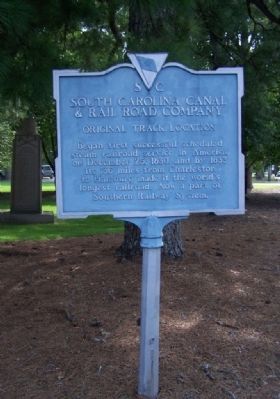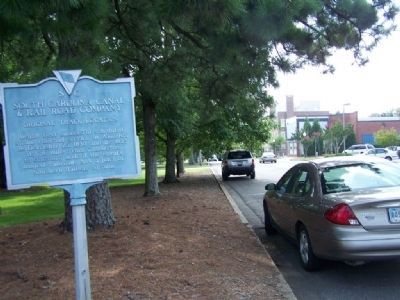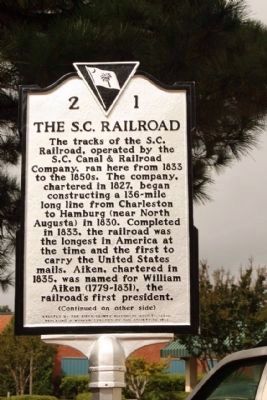Aiken in Aiken County, South Carolina — The American South (South Atlantic)
South Carolina Canal & Rail Road Company
Original Track Location
Began first successful scheduled steam railroad service in America on December 25, 1830, and by 1833 its 136 miles from Charleston to Hamburg made it the world’s longest railroad. Now part of Southern Railway System. (Marker Number 2-1.)
Topics. This historical marker is listed in these topic lists: Notable Places • Railroads & Streetcars. A significant historical month for this entry is December 1835.
Location. 33° 33.585′ N, 81° 43.412′ W. Marker is in Aiken, South Carolina, in Aiken County. Marker is on Laurens St. SW near Park Ave SW, on the right when traveling south. Touch for map. Marker is in this post office area: Aiken SC 29801, United States of America. Touch for directions.
Other nearby markers. At least 10 other markers are within walking distance of this marker. The S.C. Railroad (here, next to this marker); Woodmen Of The World (a few steps from this marker); Fallout Shelter (within shouting distance of this marker); Fred B. Cavanaugh (within shouting distance of this marker); Aiken (about 300 feet away, measured in a direct line); Plutonium-238 for Space Exploration (about 400 feet away); Dibble Memorial Library (about 400 feet away); Aiken's Jewish Merchants (about 500 feet away); Legare-Morgan House (about 600 feet away); 1953 Gas Explosion (about 600 feet away). Touch for a list and map of all markers in Aiken.
Regarding South Carolina Canal & Rail Road Company. A group of Charleston, South Carolina businessmen incorporated the South Carolina Rail Road and Canal Company (SCRRCC) in December 1827. William Aiken, one of South Carolina’s leading cotton merchants, served as president of the company between 1829 and 1831. SCRRCC wanted to develop a transportation link between Charleston and Augusta that would redirect trade that was going down the river to Savannah. Horatio Allen, an engineer from New York, selected the route from Charleston. Allen was nationally famous for supervising the first railroad in America, a short line for the Delaware and Hudson Canal Company. He was also the first person in the western hemisphere to drive a locomotive.7 The railroad line ran along the
ridge between the Ashley and Cooper Rivers, crossed the Edisto River, and then turned west,following ridges towards Augusta and terminating in Hamburg, SC opposite Augusta. Between 1830 and 1833, the SCRRCC constructed the 136‐mile, single‐track line from
Charleston to Hamburg, creating the longest passenger railroad in the world at the time. It had three sections. The main section connected Charleston to Edisto Bridge (today known as Branchville), where the line branched into east and west lines. The eastern section went to Columbia. The western section passed through the towns of White Pond, Windsor, and Montmorenci, before reaching Hamburg. The
western section was completed in the fall of1833
(City of Aiken Historic Resources Survey Report, December 22, 2010)
Also see . . .
1. South Carolina Canal & Rail Road Company. Southern Railway (now Norfolk Southern Railway) gained control of the line in 1899 and obtained a lease to the South Carolina and Georgia Railroad in 1902. The lease is still in effect. (Submitted on August 6, 2008, by Mike Stroud of Bluffton, South Carolina.)
2. Hamburg, Aiken County, South Carolina. The dead town of Hamburg, South Carolina, was once a thriving upriver market located in Edgefield District (now Aiken County). (Submitted on January 6, 2011, by Brian Scott of Anderson, South Carolina.)
3. Southern Railway. The Southern Railway (reporting mark SOU) is a former United States railroad. (Submitted on January 6, 2011, by Brian Scott of Anderson, South Carolina.)
Credits. This page was last revised on December 9, 2021. It was originally submitted on August 6, 2008, by Mike Stroud of Bluffton, South Carolina. This page has been viewed 2,759 times since then and 43 times this year. Photos: 1, 2. submitted on August 6, 2008, by Mike Stroud of Bluffton, South Carolina. 3, 4. submitted on October 7, 2010, by Mike Stroud of Bluffton, South Carolina. • Kevin W. was the editor who published this page.



